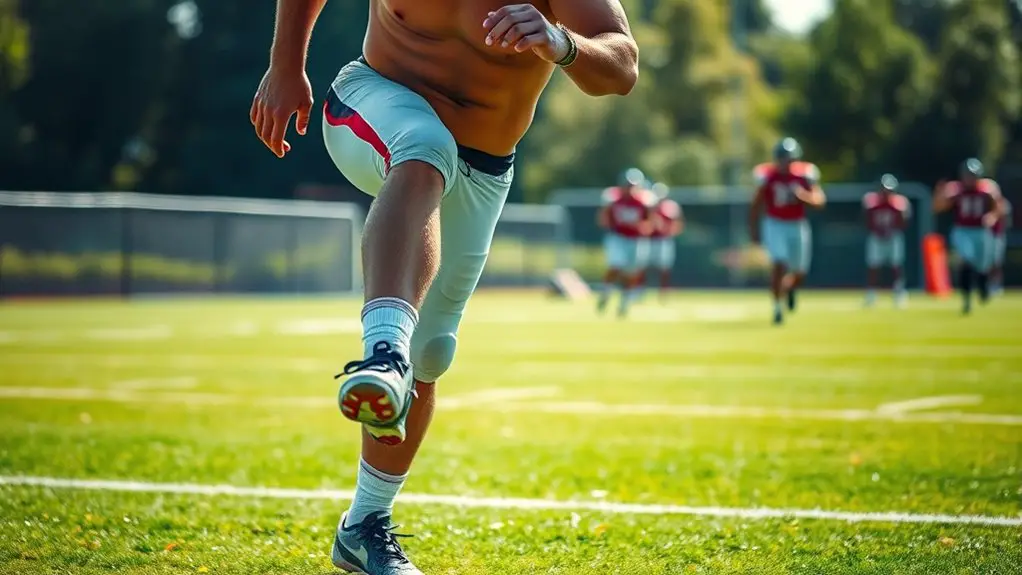Shoulder health's essential for your success as a pitcher. It affects your throwing strength, technique, and overall performance. Your shoulder's anatomy allows for motion, but injuries like rotator cuff tears can hinder your game. Early signs of trouble, like pain or weakness, shouldn't be ignored. Strengthening exercises and proper recovery can enhance your shoulder's stability and flexibility. By focusing on your shoulder health, you can boost your confidence and performance; there's more to explore about keeping your shoulders in top shape.
Understanding the Anatomy of the Shoulder
The shoulder is a complex structure, essential for a pitcher's performance. Understanding shoulder anatomy is fundamental for maintaining your freedom and mobility on the mound. Your shoulder comprises several bones, including the humerus, scapula, and clavicle, working together in a sophisticated joint structure. This design allows for a wide range of motion, enabling you to throw with power and precision.
The rotator cuff, a group of muscles and tendons, stabilizes your shoulder during intense movements. Each muscle plays a significant role, ensuring your shoulder remains resilient and capable of handling the stresses of pitching. If you grasp the intricacies of your shoulder's anatomy, you can better appreciate how to protect this valuable joint. Staying aware of how it functions helps you maintain your freedom to pitch effectively, without the fear of injury. So, embrace the complexity of your shoulder and let it empower your game. Additionally, investing in shoulder workouts can enhance your strength and stability, further supporting your pitching performance.
The Role of the Shoulder in Pitching Mechanics
Understanding how your shoulder functions in pitching mechanics is important for ideal performance and injury prevention. Your shoulder biomechanics play an essential role in how effectively you pitch. When you throw, your shoulder undergoes a complex series of movements that require strength, stability, and flexibility. If your shoulder isn't functioning properly, it can limit your pitching efficiency, leading to subpar performance.
As you wind up, your shoulder must rotate and stabilize to generate power and accuracy. During the delivery, the coordination between your shoulder, arm, and body becomes critical to maintain speed and control. A well-functioning shoulder allows for smoother motion and reduces the risk of strain or injury. Prioritizing shoulder health guarantees you can pitch freely and confidently, maximizing your potential on the mound. Remember, taking care of your shoulder isn't just about avoiding pain; it's about enhancing your game and enjoying the freedom to perform at your best. Additionally, incorporating rotator cuff strengthening exercises into your routine can significantly improve shoulder stability and overall performance.
Common Shoulder Injuries in Pitchers
As a pitcher, you're at risk for several common shoulder injuries that can seriously impact your performance. Two of the most prevalent issues are rotator cuff tears and impingement syndrome. Understanding these injuries is essential for maintaining your shoulder health and preventing long-term damage.
Rotator Cuff Tears
Rotator cuff tears are among the most common injuries pitchers face, often resulting from the repetitive stress of throwing. When you push your shoulder to its limits, the rotator cuff anatomy can suffer, leading to pain and limitations. Here's what you should know:
- Increased risk: Overuse without proper recovery can cause tears.
- Symptoms: Weakness, pain during throwing, or difficulty lifting your arm.
- Rehabilitation: Focus on rotator cuff rehabilitation to regain strength and mobility.
Ignoring these injuries can hinder your performance and freedom on the mound. Stay proactive about shoulder health; listen to your body, and prioritize recovery. After all, a strong shoulder means you can keep pitching without the fear of injury holding you back.
Impingement Syndrome Risks
When pitchers continually throw with improper mechanics or insufficient strength, they risk developing impingement syndrome, a painful condition that occurs when the shoulder's tendons become irritated or compressed. Impingement causes can include repetitive overhead motions and muscle imbalances, which lead to inflammation. If you experience impingement symptoms, such as pain during shoulder movements, weakness, or a clicking sensation, it's time to take action. Ignoring these signs can limit your freedom on the mound and lead to more serious injuries. To maintain your shoulder health, focus on proper mechanics and strength training. By addressing these issues early, you can enjoy your passion for pitching without the burden of pain and injury. Prioritize your shoulder health and keep your game strong!
Signs and Symptoms of Shoulder Issues
How can you tell if your shoulder is in trouble? Recognizing the signs and symptoms of shoulder issues is essential for maintaining your freedom on the mound. Pay attention to these key indicators:
- Shoulder pain during throws or daily activities
- Mobility issues like difficulty raising your arm or rotating your shoulder
- A persistent feeling of weakness or instability in your shoulder
If you're experiencing any of these symptoms, it's time to take a step back and assess your shoulder health. Ignoring the signs can lead to more serious problems down the line, limiting your ability to pitch effectively. Don't let shoulder pain or mobility issues hold you back. Addressing these concerns now can help you preserve your range of motion and keep you in the game longer. Trust your instincts; your body knows when something's off. Remember, proper warm-ups and stretching exercises are crucial for prevention of injuries.
The Impact of Poor Shoulder Health on Performance
Ignoring shoulder issues can seriously impact your performance on the mound. When you push through pain or discomfort, you're setting yourself up for shoulder fatigue that can lead to a performance decline. Your shoulder plays a vital role in pitching; if it's not functioning at its best, every throw can feel like a struggle. You might notice a drop in velocity or control, which can affect your confidence and overall game.
Not only can poor shoulder health cause immediate issues, but it can also lead to long-term consequences that keep you sidelined. If you're not addressing shoulder problems now, you risk losing your edge and the freedom you crave on the field. You want to pitch at your best, so don't let shoulder fatigue dictate your performance. Stay proactive about your shoulder health to maintain that competitive spirit and guarantee every pitch showcases your true potential. Additionally, proper warm-up routines are essential to prevent shoulder fatigue and injury, allowing you to perform at your peak.
Importance of Pre-Season Shoulder Conditioning
Pre-season shoulder conditioning is essential for pitchers like you, as it sets the foundation for a strong and healthy arm. By focusing on strengthening your rotator cuff muscles and incorporating flexibility and mobility exercises, you can greatly reduce your risk of injury. Implementing effective injury prevention strategies now will pay off throughout the season. Additionally, prioritizing flexibility training can enhance joint fluidity and further protect your shoulders from overuse injuries.
Strengthening Rotator Cuff Muscles
Since the shoulder is crucial for pitchers, strengthening the rotator cuff muscles during the pre-season is necessary for preventing injuries and enhancing performance. A strong rotator cuff not only supports shoulder stability but also guarantees your pitching mechanics remain fluid and powerful.
Here are some key benefits of focusing on your rotator cuff:
- Injury Prevention: Strengthening these muscles reduces the risk of tears and strains.
- Improved Power: A stable shoulder allows for more forceful pitches, enhancing your overall performance.
- Better Control: Strengthening the rotator cuff supports better mechanics, leading to increased accuracy.
Flexibility and Mobility Exercises
To complement the strengthening of your rotator cuff, incorporating flexibility and mobility exercises is essential for shoulder conditioning. Dynamic stretches are a fantastic way to prepare your muscles for the demands of pitching. Focus on movements that mimic your throwing motion, helping to improve your range of motion and overall shoulder function. Using resistance bands can also enhance your shoulder's mobility; they're great for targeting specific muscles while promoting flexibility. Simple exercises like band pull-aparts and external rotations can make a significant difference. Prioritizing these exercises before the season not only boosts your performance but also gives you the freedom to pitch confidently, knowing your shoulders are well-conditioned and ready for action. Embrace this routine, and feel the benefits unfold!
Injury Prevention Strategies
While it's easy to overlook shoulder conditioning during the off-season, prioritizing pre-season preparation is essential for pitchers. By focusing on shoulder stability, you can greatly reduce your risk of injury and enhance your performance on the mound.
Here are a few strategies to implement:
- Incorporate dynamic warm ups: These help activate relevant muscle groups and improve blood flow.
- Strengthen rotator cuff muscles: Targeting these muscles boosts shoulder stability and supports your throwing motion.
- Practice proper throwing mechanics: Focus on technique to prevent unnecessary strain on your shoulder.
Effective Shoulder Strengthening Exercises
Strengthening your shoulders is essential for any pitcher looking to enhance performance and prevent injuries. Incorporating effective exercises into your routine can boost shoulder stability and support your throwing mechanics. One great way to do this is by using resistance bands.
Start with external rotations: anchor the band, hold the other end, and rotate your arm outward, keeping your elbow close to your body. This targets the rotator cuff muscles, promoting stability.
Next, try shoulder presses with the bands. Stand on the band, grasp it with both hands, and press upward. This builds overall shoulder strength, vital for powerful pitching.
Don't forget lateral raises! Stand on the band, grab the ends, and raise your arms to the side. This exercise helps develop the deltoids, enhancing shoulder function.
Stretching and Flexibility for Shoulder Health
Maintaining flexibility in your shoulders is just as essential as building strength, especially for pitchers who rely on a full range of motion during their throwing mechanics. Incorporating stretching and flexibility routines can help you avoid injuries and enhance performance. Here are some key practices to evaluate:
- Dynamic stretches: These activate your muscles and increase blood flow, making them perfect before you hit the field.
- Foam rolling: This technique helps release muscle tightness and improve mobility, ensuring your shoulders can move freely. Regularly incorporating foam rolling techniques can enhance your overall performance and reduce discomfort.
- Static stretches: Incorporate these post-workout to maintain your shoulder flexibility and promote recovery.
The Role of Recovery and Rehabilitation
Recovery and rehabilitation are essential for pitchers, as they not only help you bounce back from injuries but also enhance your overall shoulder health. To keep your shoulder in peak condition, you'll want to explore effective recovery techniques tailored to your needs. These could include ice therapy, massage, or targeted exercises that promote healing.
Adhering to rehabilitation protocols is equally vital. These protocols guide you through a structured approach, ensuring you regain strength and flexibility without overexerting yourself. By following these protocols, you can gradually return to throwing without risking further injury.
Don't underestimate the power of rest, either. Giving your shoulder time to recuperate allows you to pitch with confidence and agility. Incorporating proper nutrition strategies to support muscle rebuilding can further enhance your recovery process. Embrace these recovery and rehabilitation strategies, and you'll not only improve your performance but also enjoy the freedom to play the game you love without the fear of recurring injuries.
Long-Term Strategies for Shoulder Maintenance
While you may focus on immediate recovery, it's crucial to adopt long-term strategies for shoulder maintenance that can prevent future issues. Prioritizing shoulder stability and effective injury management will help you maintain your performance and freedom on the mound. Here are three key strategies to keep in mind:
- Strengthening Exercises: Incorporate rotator cuff and scapular stabilizer exercises into your routine to enhance shoulder stability.
- Mobility Work: Regularly engage in shoulder mobility drills to maintain flexibility and prevent stiffness.
- Consistent Recovery Practices: Implement a routine that includes rest, ice, and active recovery techniques to promote healing and resilience. Additionally, integrating flexibility and mobility work into your training fosters freedom of movement in sports.
Frequently Asked Questions
How Can Nutrition Affect Shoulder Health in Pitchers?
Nutrition plays an essential role in your shoulder health, and it's not just about what you eat. While you might think of meals, nutrient timing's equally important; fueling your body at the right moments can enhance recovery. You can't ignore hydration strategies either, as water supports joint function. Balancing your nutrients and staying hydrated gives you the freedom to perform at your best, keeping your shoulders strong and reducing injury risks.
What Role Does Mental Health Play in Shoulder Recovery?
Mental health plays an essential role in shoulder recovery, as your mindset can influence healing. When you've got strong mental resilience, you're better equipped to face setbacks. Embracing coping strategies, like mindfulness or visualization, can help you manage stress and maintain motivation. Remember, recovery isn't just physical; it's a holistic process. By prioritizing your mental well-being, you're paving the way for a smoother and more effective recovery journey.
Are There Specific Shoulder Injuries Unique to Youth Pitchers?
Absolutely, there are specific shoulder injuries unique to youth pitchers. Young athletes often experience overuse injuries due to their developing bodies, especially around the growth plate. Their shoulders aren't fully matured, which makes them more susceptible to strain and injury from repetitive pitching. It's essential to monitor their throwing frequency and guarantee they take breaks, allowing their bodies to grow and recover. Prioritizing proper mechanics can also help prevent these injuries.
How Does Weather Impact Shoulder Performance and Health?
Weather can really affect your shoulder performance and health. Temperature fluctuations can lead to muscle stiffness or tightness, making it tougher to throw effectively. High humidity levels might increase the risk of dehydration, which can impact your overall mobility. When you're playing in less-than-ideal conditions, it's essential to listen to your body and adjust your warm-up routine. Staying aware of these factors can help you maintain better shoulder health and performance.
What Equipment Can Help Prevent Shoulder Injuries in Pitchers?
You'd think shoulder injuries are lurking like monsters under your bed, right? Fear not! To keep those pesky injuries at bay, consider equipment like resistance bands for shoulder strengthening, or a stability ball to boost your core support. These tools make injury prevention feel like a walk in the park. By using them regularly, you can enjoy pitching without worrying about those hidden monsters. So, gear up and pitch with confidence!




